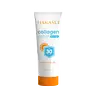What's inside
What's inside
 Key Ingredients
Key Ingredients

 Benefits
Benefits

 Concerns
Concerns

 Ingredients Side-by-side
Ingredients Side-by-side

Water
Skin ConditioningEthylhexyl Methoxycinnamate
UV AbsorberDiethylamino Hydroxybenzoyl Hexyl Benzoate
UV FilterNeopentyl Glycol Diheptanoate
EmollientButylene Glycol
HumectantEthylhexyl Triazone
UV AbsorberTris-Biphenyl Triazine
UV AbsorberButyl Methoxydibenzoylmethane
UV AbsorberNiacinamide
SmoothingBis-Ethylhexyloxyphenol Methoxyphenyl Triazine
Skin ConditioningButyloctyl Salicylate
Skin ConditioningInositol
HumectantOctocrylene
UV AbsorberGlycine Soja Oil
EmollientPhenoxyethanol
PreservativePolyester-7
Skin ConditioningAcrylates/C10-30 Alkyl Acrylate Crosspolymer
Emulsion StabilisingDecyl Glucoside
CleansingCarbomer
Emulsion StabilisingDisodium EDTA
Polyglyceryl-3 Diisostearate
EmulsifyingSodium Polyacrylate
AbsorbentHydrogenated Polydecene
EmollientLactobacillus/Collagen Ferment Filtrate
HumectantLecithin
EmollientOryza Sativa Germ Extract
EmollientSodium Hydroxide
BufferingTocopheryl Acetate
AntioxidantTriethylene Glycol
MaskingDisodium Phosphate
BufferingTrideceth-6
EmulsifyingXanthan Gum
EmulsifyingArtemisia Vulgaris Extract
Skin ConditioningWater, Ethylhexyl Methoxycinnamate, Diethylamino Hydroxybenzoyl Hexyl Benzoate, Neopentyl Glycol Diheptanoate, Butylene Glycol, Ethylhexyl Triazone, Tris-Biphenyl Triazine, Butyl Methoxydibenzoylmethane, Niacinamide, Bis-Ethylhexyloxyphenol Methoxyphenyl Triazine, Butyloctyl Salicylate, Inositol, Octocrylene, Glycine Soja Oil, Phenoxyethanol, Polyester-7, Acrylates/C10-30 Alkyl Acrylate Crosspolymer, Decyl Glucoside, Carbomer, Disodium EDTA, Polyglyceryl-3 Diisostearate, Sodium Polyacrylate, Hydrogenated Polydecene, Lactobacillus/Collagen Ferment Filtrate, Lecithin, Oryza Sativa Germ Extract, Sodium Hydroxide, Tocopheryl Acetate, Triethylene Glycol, Disodium Phosphate, Trideceth-6, Xanthan Gum, Artemisia Vulgaris Extract
Water
Skin ConditioningGlycerin
HumectantEthylhexyl Methoxycinnamate
UV AbsorberButyl Methoxydibenzoylmethane
UV AbsorberEpilobium Angustifolium Flower/Leaf/Stem Extract
Skin ConditioningAcrylates Crosspolymer
AbsorbentInulin Lauryl Carbamate
Emulsion StabilisingEthylhexyl Triazone
UV AbsorberChlorphenesin
AntimicrobialBisabolol
MaskingSodium Hyaluronate
HumectantBakuchiol
AntimicrobialEctoin
Skin ConditioningPhenoxyethanol
PreservativeOctocrylene
UV AbsorberSodium Surfactin
CleansingQuaternium-73
Water, Glycerin, Ethylhexyl Methoxycinnamate, Butyl Methoxydibenzoylmethane, Epilobium Angustifolium Flower/Leaf/Stem Extract, Acrylates Crosspolymer, Inulin Lauryl Carbamate, Ethylhexyl Triazone, Chlorphenesin, Bisabolol, Sodium Hyaluronate, Bakuchiol, Ectoin, Phenoxyethanol, Octocrylene, Sodium Surfactin, Quaternium-73
 Reviews
Reviews

Ingredients Explained
These ingredients are found in both products.
Ingredients higher up in an ingredient list are typically present in a larger amount.
Also known as Avobenzone, this ingredient is a chemical sunscreen filter that provides protection in the UV-A range.
Avobenzone is globally approved and is the most commonly used UV-A filter in the world.
Studies have found that avobenzone becomes ineffective when exposed to UV light (it is not photostable; meaning that it breaks down in sunlight). Because of this, formulations that include avobenzone will usually contain stabilizers such as octocrylene.
However, some modern formulations (looking at you, EU!) are able to stabilize avobenzone by coating the molecules.
Avobenzone does not protect against the UV-B range, so it's important to check that the sunscreen you're using contains other UV filters that do!
The highest concentration of avobenzone permitted is 3% in the US, and 5% in the EU.
Learn more about Butyl MethoxydibenzoylmethaneEthylhexyl Methoxycinnamate is an organic compound that provides UVB protection. It often goes by the more common name of octinoxate. It is created from methoxycinnamic acid and 2-ethylhexanol.
Ethylhexyl Methoxycinnamate absorbs UVB rays with wavelengths between 280-320 nm. UV absorbers protect your skin by using chemical reactions to convert UV rays into heat and energy.
UVB (290-320 nm) rays emit more energy than UVA rays. They are capable of damaging DNA, causing sunburns and are thought to be linked to skin cancer.
The state of Hawaii has banned sunscreens containing octinoxate due to its potential impact on coral reefs. More research is needed to bridge gaps in this research. The European Union allows higher levels of octinoxate in sunscreens than the US and Australia.
Ethylhexyl Methoxycinnamate is oil soluble. It is not stable and may lose efficacy when exposed to sunlight.
Learn more about Ethylhexyl MethoxycinnamateEthylhexyl Triazone is a modern chemical sunscreen that protects from UV-B radiation.
It is the most effective of existing UV-B filters, as it provides the highest level of photo-stable absorption. It protects from the entire UV-B range (280 to 320nm), with it's highest level of protection at 314nm.
Ethylhexyl Triazone is oil soluble, oderless and colorless, which mean it is able to be incorporated into a variety of different formulations.
It is not currently available within the United States due to slow changing FDA regulations. Outside of the US, it is used in formulations at concentrations up to 5%.
Learn more about Ethylhexyl TriazoneOctocrylene protects skin from sun damage. It absorbs UV-B with peak absorption of 304 nm. It is a common sunscreen ingredient and often paired with avobenzone, a UVA filter. This is because octocrylene stabilizes other sunscreen ingredients by protecting them from degradation when exposed to sunlight. Octocrylene is a photostable ingredient and loses about 10% of SPF in 95 minutes.
Octocrylene also acts as an emollient, meaning it helps skin retain moisture and softens skin. It is oil-soluble and hydrophobic, enhancing water-resistant properties in a product.
Those who are using ketoprofen, a topical anti-inflammatory drug, may experience an allergic reaction when using octocrylene. It is best to speak with a healthcare professional about using sunscreens with octocrylene.
The EU allows a maximum of these concentrations:
Learn more about OctocrylenePhenoxyethanol is a preservative that has germicide, antimicrobial, and aromatic properties. Studies show that phenoxyethanol can prevent microbial growth. By itself, it has a scent that is similar to that of a rose.
It's often used in formulations along with Caprylyl Glycol to preserve the shelf life of products.
Water. It's the most common cosmetic ingredient of all. You'll usually see it at the top of ingredient lists, meaning that it makes up the largest part of the product.
So why is it so popular? Water most often acts as a solvent - this means that it helps dissolve other ingredients into the formulation.
You'll also recognize water as that liquid we all need to stay alive. If you see this, drink a glass of water. Stay hydrated!
Learn more about Water